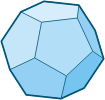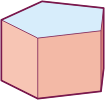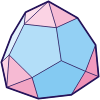Convex polyhedra are polyhedra which are more
or less ball shaped. This might sometimes hard to imagine if you
consider a pyramid to be a convex polyhedron. Another definition might
be that all dihedral angles are less than 180 degrees (although this
definition is not entirely true). You can check if a polyhedron
is convex to connect two vertexes of the polyhedron with a string. If
this string is always running over the surface of the polyhedron (regardless
the vertexes used), then this sphere is convex. If the string is
running through the air (as in a star) than the polyhedron is
non-convex.
Most puzzles described on this website are
related to convex polyhedra. Therefore this is an important topic if
you are working with puzzles. Furthermore are most non-convex
polyhedra related to the convex polyhedra.

|
4 Families
Here you can find the basic of
polyhedra. Four families will be described: the Rhombic,
Platonic, Archimedic and Catalan Polyhedra. It will also be
shown that there will be four families in another way: the
trigonal, tetragonal, pentagonal and hexagonal family.
|

|
Half-Regular
Polyhedra
In this chapter other half-regular
polyhedra will be described. You can think of pyramids,
prisms, anti prisms, double pyramids and trapezoids
|

|
Johnson
Polyhedra
Norman Johnson has described all
possible convex polyhedra build out of regular polygons. Next
to the Platonic and Archimedic solids and the prisms he has
found 77 other polyhedra who are now known by the name Johnson
polyhedra
|

|
Deeper into
Irregularity The number of
convex polyhedra is of course endless. Based upon the regular
and half regular polyhedra it is possible to make more
polyhedra which can be quite useful as basis for puzzles. |
 |
Previous
menu
Click here to return to the main menu |